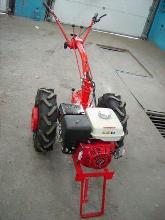Categories: Sharing experience, Electrician Secrets
Number of views: 221979
Comments on the article: 19
Homemade Power Station
 Manual for the manufacture of a homemade electric generator 220/380 V.
Manual for the manufacture of a homemade electric generator 220/380 V.
Those who often leave the city know that a complete lack of electricity or its frequent blackout is not uncommon. People struggle with this by buying gas generators or kerosene lamps and stearin candles.
But there is another way. Motoblock, for plowing and cleaning gardens, has become a national hit. Experience has shown that it can be adapted to generate electricity. As a generator, you can use an asynchronous electric motor, for example, the AIR series. The electric motor must be with a rotation speed of 800-1600 rpm and a power of up to 15 kW.
The motoblock engine and the electric motor are connected using two pulleys and a drive belt. The diameter of the pulleys is chosen so that the rotational speed of the electric motor as a generator is 10-15% higher than the rated value of the speed of the electric motor.
The motor windings are connected by a star, and capacitors are connected in parallel to each pair of windings. They form a triangle. Voltage is removed between the midpoint and the end of the winding. Between the windings, 380 V is obtained, between the midpoint and the end of the winding 220 V. To maintain the correct start-up and operation of the generator, capacitors are selected. All three capacitors have the same capacitance. The relationship between the capacitance of the capacitors and the power of the generator can be seen in the table.
 For active load, one capacitor is enough.
For active load, one capacitor is enough.
To use all three phases to power a single-phase instrument, a three-phase transformer must be used.
If the generator is very hot during operation, the capacitance of the capacitors must be reduced.
Capacitors must be at least 400 V.
Power plants of this kind can also be used for heating a house. True, a gasoline engine should be more powerful, but given that the rusty Oka or Vaz 2101 can be bought for a penny, and then using their engine is no longer a problem.
Read also:Wind generators: how to choose, install and avoid disappointment
See also at bgv.electricianexp.com
:
